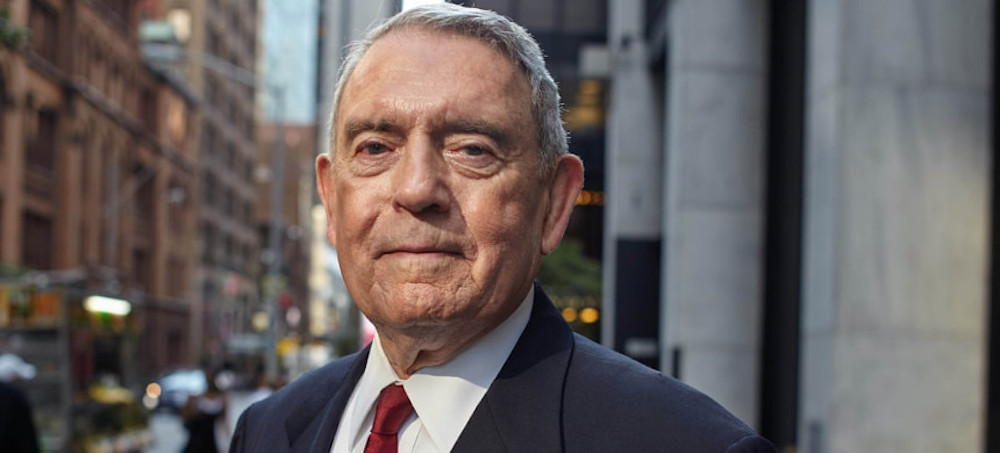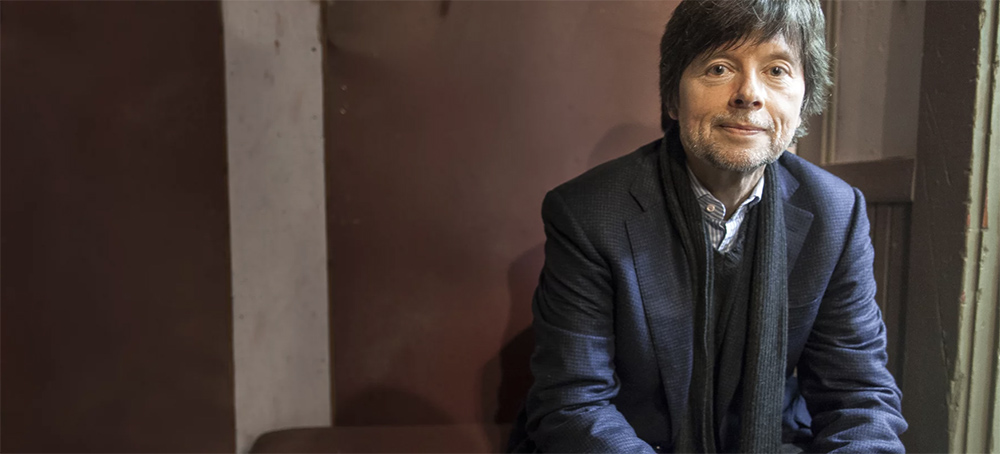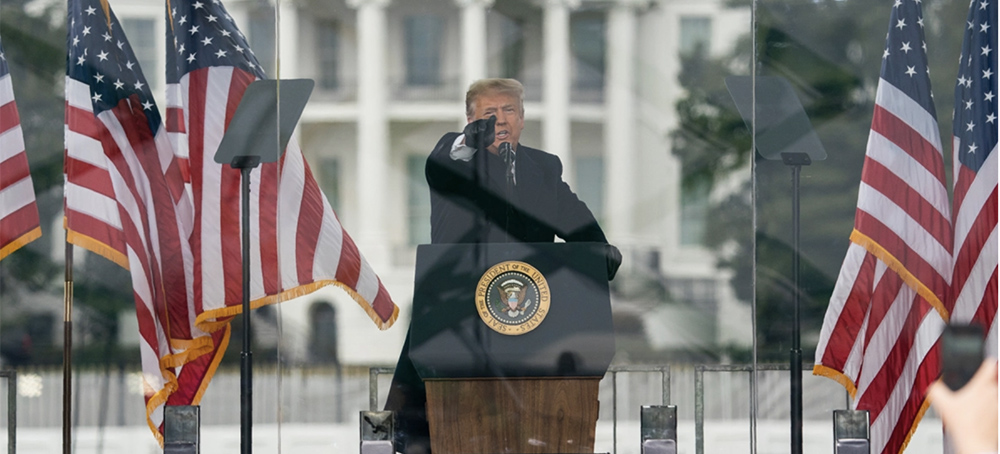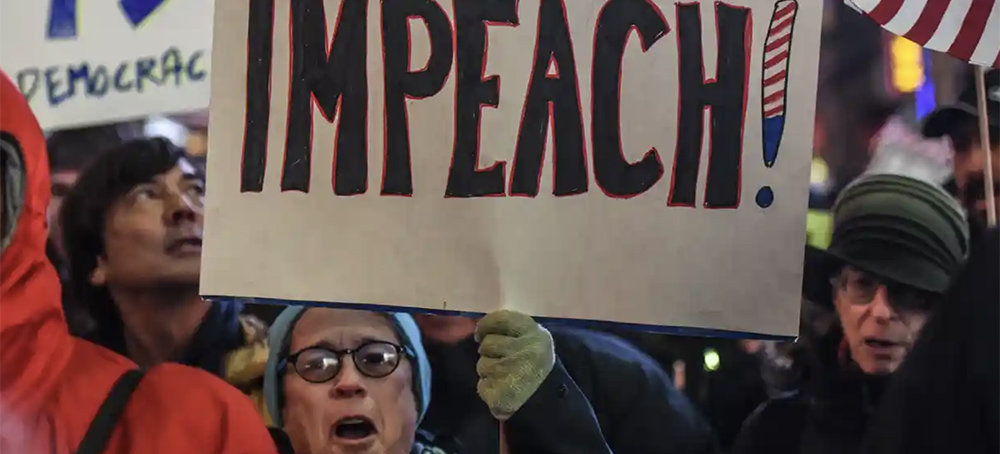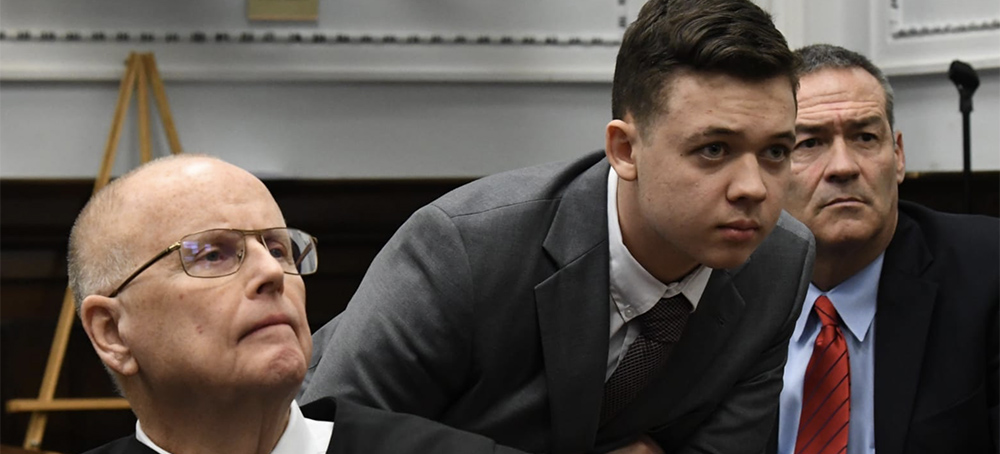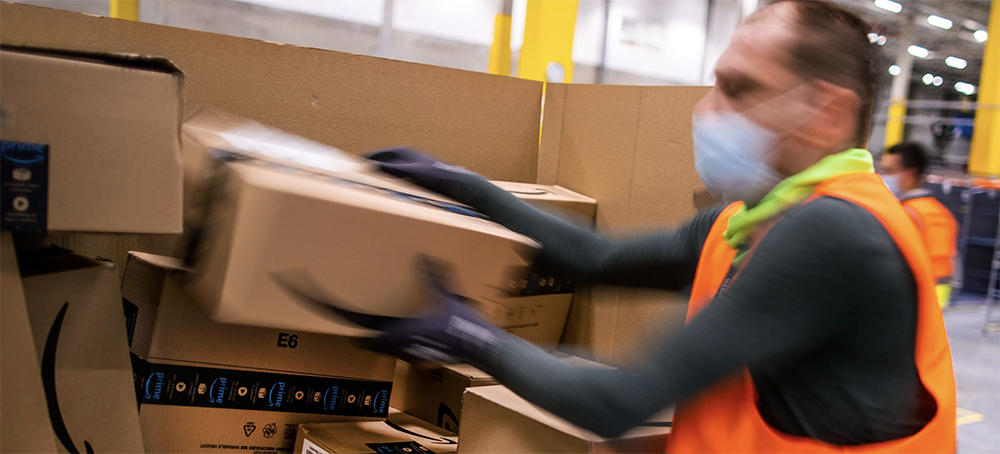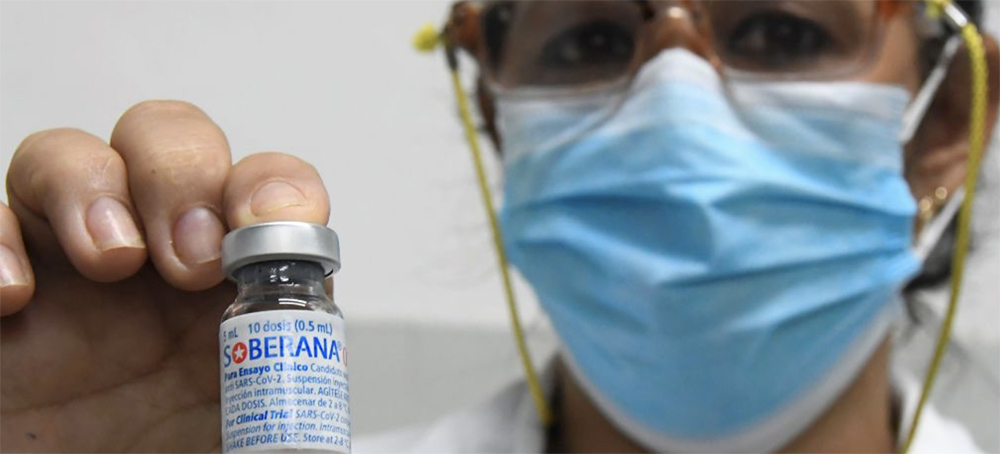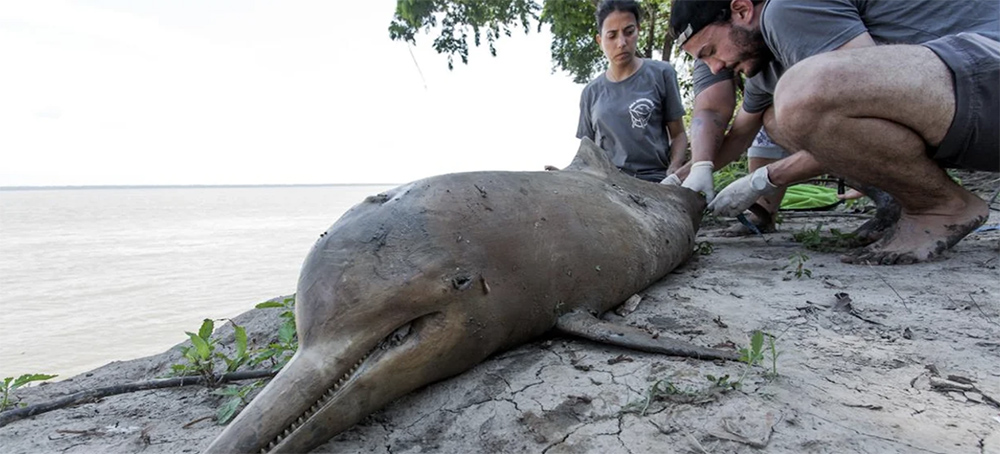Live on the homepage now!
Reader Supported News
“Merry Christmas.”
When I hear “Merry Christmas,” it often has the power to transport me across time.
I can see myself as an eager child, gathering with extended family, faces full of life and now mostly long gone. I am awaiting the few gifts that my parents could afford to give in a house small of size but full of love and opportunity.
I can see the years of my own young family. I am often rushing back from a distant assignment to share the holiday with my wife, children, and other friends and family. Life in those moments always felt hopeful, especially in the excited eyes of the young.
I think of Christmas times visiting troops stationed overseas knowing that they would be far away when their children and families gathered around the tree. And I remember knowing that some in combat zones might never return. I always pray for them.
And I feel the Christmas of the present, the second consecutive year amid a global pandemic. I am thinking of all those who have fallen to the deadly disease and how many empty seats there will be at Christmas dinners. I think of canceled plans and gatherings that will never occur, especially now with a new surging variant. There is great sadness for many, including likely some of you. I send all who have suffered and are suffering my heartfelt sympathies.
I send a deep thanks to all the healthcare workers, the nurses, doctors, orderlies, lab workers, and all the others who now face another Christmas of stress and surging cases. That your work has been made more difficult by those who would politicize vaccines and public health measures is particularly tragic.
I am grateful for all of you who do the hard work to keep our world functioning. I see all of you teachers whose jobs, never easy and so important, have been made so much more challenging by remote learning and the traumas the children have been going through. I see also the grocery clerks, delivery drivers, warehouse and factory workers, and all the others whose labor keeps food and goods moving.
I am also full of gratitude for the scientists who developed remarkable vaccines in record time and are working to develop new therapeutics and versions of the vaccines to address this wiley viral enemy. Many of us literally owe you our lives.
As I sit in Austin Texas, back living full-time in the state into which I was born more than nine decades ago, I am deeply grateful for a life of good fortune. I have been blessed with family, health, and a lifetime of work that I have loved. And that includes having this venue to share our difficult moment in history with all of you. This newsletter fills me with more happiness than you could imagine.
Among the many joys of life of which this virus has robbed us is the power that comes from gathering with others.
I think of time in the pews of church, my meager singinging abilities uplifted and amplified by all around me. I think of Christmas parties and meaningful conversations with the many people who have enriched my life. I think of bustling stores filled with smiling faces - smiles now necessarily hidden by facemasks.
What I hope we can do with Steady is create a place for people to gather, even if only digitally, to share this life and world together. We talk mostly about the challenges we face, and for good reason. They are grave and urgent. But I also hope we can share some of the happiness of life and remind each other that we are not alone. That is only possible because of all of you. So thank you once again for joining us on this quixotic journey.
Finally, in this already-too-long Christmas note, if you will indulge me, I wanted to share an excerpt from the “Empathy” essay from our book What Unites Us. It is about this time of year and one of my most formative memories from my childhood. The setting is the dirt street on which I lived on what was then the distant outskirts of Houston, Texas during the Great Depression.
Across our street was a poor frame house in a state of semicollapse. A half block down lived a family who didn’t even have a house, just a corrugated tin roof held up by four posts in the corners and one in the middle. Their floor was dirt. Nobody in either of these families had a job. That was not unusual in our neighborhood during the Depression...
The father of the family in the dilapidated house had lost a leg. Exactly how he’d lost it was unclear, but the prevailing belief was that it had happened after a misjudged leap from a boxcar. Riding the rails was not uncommon then as a means to get to your destination, but it was uncommonly dangerous. His condition brought a crushing change to his fortune and that of his family. Before the accident, the father had been a day laborer for hire, a man with a shovel who could dig you a ditch. But there wasn’t much demand for a one-legged ditchdigger. He had likely not gotten good medical attention after the accident, and I remember him clearly as a frail man with a bad cough. He, his wife, and their four or five children had no money. Zero. They eventually applied for some form of relief, but it came only sporadically.
The family under the tin roof had a passel of kids as well, maybe as many as six. I remember thinking how elderly the father was, although he was probably much younger than he looked. A hard life will do that to a person. For some reason this other family, despite their abject poverty, didn’t seem to qualify for the government’s new “relief” program (otherwise known as “the dole”). Perhaps they didn’t know how to fill out the paperwork. Public support was far less systematic than it is today. Around the neighborhood, this family had a reputation for often being in prayer, and as a boy I wondered how God could be so seemingly blind to such suffering.
The neighborhood tried as best it could to help these families stay alive. If we had leftovers after supper, we would walk them across the street. One of my earliest impressions was taking that short journey with my father. You might think that these families were humiliated by the offerings, but there is no dignity in being hungry. And there was no judgment or disdain on the part of those offering assistance. No one wondered why those neighbors weren’t working, and no one passed moral judgments on their inability to fend for themselves. We understood that, in life, some are dealt aces, some tens, and some deuces.
Food wasn’t the only assistance we provided. One morning I watched my uncle John dig a ditch from our house across the gravel road to the ramshackle house. The family had been unable to pay their water bills, and my uncle was good with pipes. So he connected the two houses, and we shared our water with them. These acts of kindness were also not unusual among neighbors. Necessity was a great motivator for innovation and empathy.
On Christmas Eve, my father and uncle pooled their money, meager though it was, and bought toys for the families living in the dilapidated house and under the tin roof. I remember a rag doll, a small wooden train, and for some reason a tambourine — why these details are so vivid I couldn’t say. We waited until after the children had gone to bed to give the gifts quietly to the parents, so that when those children woke up the next morning they would not think Santa had forsaken them. That was the hope, anyway.
What sticks with me more than even that act of kindness was how my mother talked to me about it. I was an inquisitive child (perhaps not surprising considering my later path in life), and I was always asking questions. So I asked my mother why we gave those families gifts at Christmas when we ourselves didn’t have much. I remember then answering for myself: “It was because we felt sorry for them, right?”
“We do not feel sorry for them,” my mother said sternly. “We understand how they feel.” It was a lesson that is so seared in my mind, I can see her face and I can hear her tone of voice as if it were yesterday.
May we all endeavor this holiday season, and in the new year and all the challenging times sure to follow, to try to “understand how they feel.” This cannot be a recipe for false equivalence. It does not mean sacrificing one’s own beliefs. Rather it is a realization that we are bound together by a common humanity and the more we can recognize that in ourselves and others, the more we can go about doing the hard work of making this world a better place.
As I have read your comments here on Steady over the past year, I see a community of empathy, and thus hope. So thank you once more.
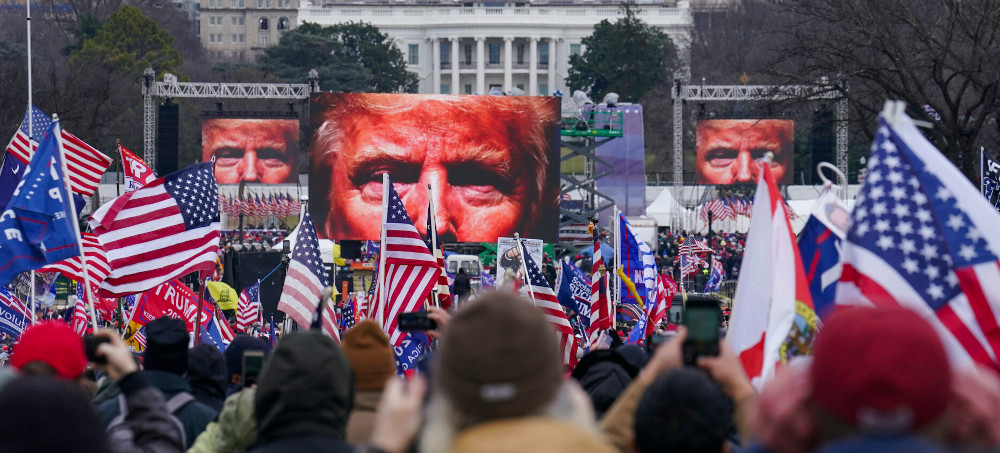 Trump supporters rally in Washington on Jan. 6, 2021, ahead of a joint session of Congress to certify the results of the 2020 presidential election. (photo: John Minchillo/AP)
Trump supporters rally in Washington on Jan. 6, 2021, ahead of a joint session of Congress to certify the results of the 2020 presidential election. (photo: John Minchillo/AP)
An appeals court ruled against the former US president two weeks ago but prohibited documents from being turned over
A federal appeals court ruled against the former US president two weeks ago, but prohibited documents held by the National Archives from being turned over before the supreme court had a chance to weigh in. Trump appointed three of the nine justices.
Trump is claiming that as a former president he has right to assert executive privilege over the records, arguing that releasing them would damage the presidency in the future.
But Joe Biden determined that the documents were in the public interest and that executive privilege should therefore not be invoked.
The documents include presidential diaries, visitor logs, speech drafts, handwritten notes “concerning the events of January 6” from the files of former chief of staff Mark Meadows, and “a draft executive order on the topic of election integrity”, the Archives has said.
The House committee has said the records are vital to its investigation into the run-up to the deadly riot that was aimed at overturning the results of the 2020 presidential election.
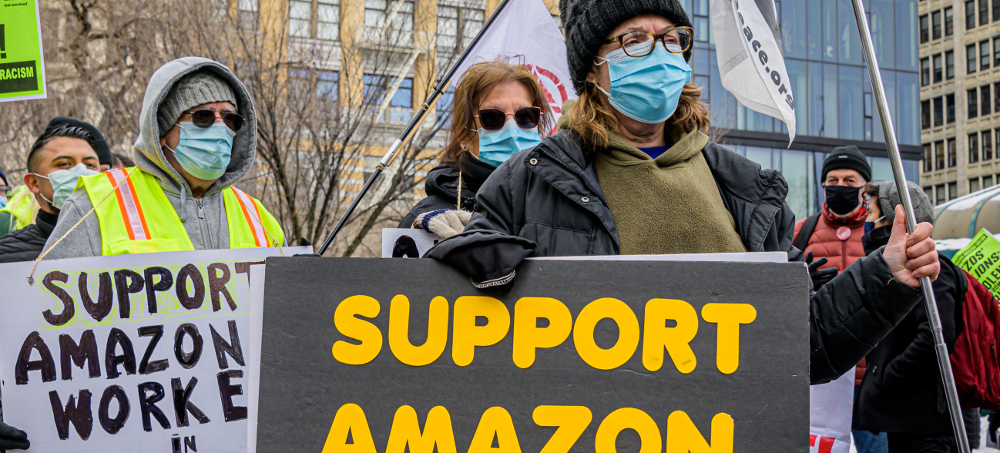 Amazon has reached a settlement with the National Labor Relations Board. (photo: Erik McGregor/Getty)
Amazon has reached a settlement with the National Labor Relations Board. (photo: Erik McGregor/Getty)
According to the settlement, the online behemoth Amazon said it would reach out to its warehouse workers — former and current — via email who were on the job anytime from March 22 to now to notify them of their organizing rights. The settlement outlines that Amazon workers, which number 750,000 in the U.S., have more room to organize within the buildings. For example, Amazon pledged it will not threaten workers with discipline or call the police when they are engaging in union activity in exterior non-work areas during non-work time.
According to the terms of the settlement, the labor board will be able to more easily sue Amazon— without going through a laborious process of administrative hearings — if it found that the online company reneged on its agreement.
"Whether a company has 10 employees or a million employees, it must abide by the National Labor Relations Act," said NLRB General Counsel Jennifer Abruzzo, in a statement. "This settlement agreement provides a crucial commitment from Amazon to millions of its workers across the United States that it will not interfere with their right to act collectively to improve their workplace by forming a union or taking other collective action."
She added that "working people should know that the National Labor Relations Board will vigorously seek to ensure Amazon's compliance with the settlement and continue to defend the labor rights of all workers."
Amazon.com Inc., based in Seattle, couldn't be reached immediately for comment.
A labor scholar says the settlement is a big step by Amazon
Kent Wong, the director of the UCLA Labor Center, called the settlement "unprecedented" and said it represents a sea change in attitude at Amazon, which is known to deploy fierce measures against union activity at its warehouses.
"Amazon has been very consistent in holding a strong anti-union position, " Wong said. "This opens up a new opportunities for unionization there as well as at other companies."
Wong noted that the settlement comes as Amazon, the nation's second-largest private employer after Walmart, is on a hiring binge while facing organizing efforts at warehouses in Alabama and New York.
In November, the labor board ordered a new union election for Amazon workers in Bessemer, Alabama, based on objections to the first vote that took place in April. The move was a blow to Amazon, which spent about a year aggressively campaigning for the Bessemer warehouse workers to reject the union, which they ultimately did by a wide margin. The board had not yet determined the date for the second election, and it hasn't determined whether it will be conducted in person or by mail.
The campaign is being spearheaded by the Retail, Wholesale and Department Store Union.
Meanwhile, on Wednesday, the Amazon Labor Union, an independent group representing workers in New York's Staten Island borough, refiled its petition for a union election. The group of workers withdrew its first petition in mid-November to hold a vote to unionize after falling behind the adequate number of workers pledging support. Former Amazon employee Christian Smalls is organizing the effort in Staten Island without the help of a national sponsor.
The organizing drive is also happening during a moment of reckoning across Corporate America as the pandemic and ensuing labor shortage has given employees more leverage to fight for better working conditions and pay. Workers have staged strikes at Kellogg's U.S. cereal plants as well as at Deere & Co., to name a few.
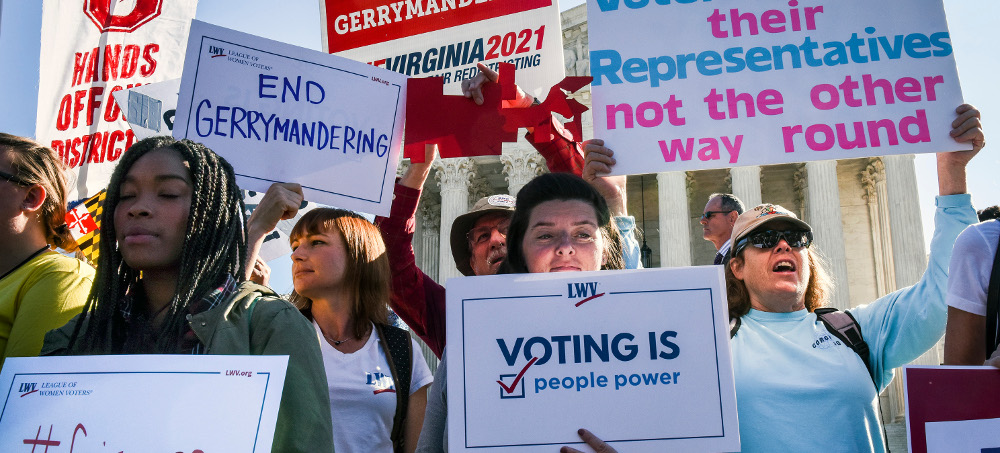 'This year Republicans have managed to take fully 40 percent of competitive House seats out of play.' (photo: Getty)
'This year Republicans have managed to take fully 40 percent of competitive House seats out of play.' (photo: Getty)
Thanks to a breathtaking abuse of redistricting in GOP-controlled states, all but an unlucky handful of members of Congress will henceforth be exempt from listening to those god-awful whiners called “voters,” spared those bothersome contests known as “elections” and protected from other disagreeable requirements of “democracy.”
This year Republicans have managed to take fully 40 percent of competitive House seats out of play. All but about 25 seats of the 435 in the entire country will be insulated from the will of voters even during wave elections — not just for 2022, but for a decade.
The move might limit Republicans’ upside in next year’s midterms (they had to toss Democrats a few more safe seats to shore up their own), but it could also keep them in the majority for years, even if the national popular vote goes consistently against them. Already, Republicans could lose the popular vote by two or three percentage points and still control the House.
The changes guarantee more extremism in Congress (the only competitive elections will be primaries, which on the GOP side favor the far right), and whichever party is in control will have a slim, ungovernable majority.
The worst offender is Texas, where President Biden got nearly 47 percent of the vote in 2020 and Democratic Senate candidate Beto O’Rourke got more than 48 percent in 2018. Republicans redrew maps to give themselves both of Texas’s new congressional seats (even though most of the population growth was in Democratic-leaning communities of color), and they reduced the number of competitive House seats from six to one.
Democrats get nearly half the popular vote in Texas, but they can expect just a third of the House seats (13 of the 38). In order to get above 37 percent of the seats (that is, more than 14 seats), they would have to win an inconceivable 58 percent of the statewide popular vote. Republicans “have rendered elections meaningless, basically,” Michael Li, senior counsel at the Brennan Center for Justice, a voting rights group, tells me. And “it’s all at the expense of communities of color.”
Dave Wasserman, redistricting maven with the nonpartisan Cook Political Report, forecasts a 30 percent to 40 percent decline in competitive House races from the 51 there were in 2020. Using slightly different measures, the National Democratic Redistricting Committee (NDRC), formed by former attorney general Eric Holder, calculates that 15 of 38 competitive seats from the 2020 election (meaning those decided by 5 percentage points or fewer) have already been redrawn as safe seats.
In addition to Texas, other redistricting abusers include North Carolina, where Biden got 48.6 percent of the vote but Republicans are attempting to control 11 of the state’s 14 House seats; and Ohio, where Biden got 45.2 percent of the vote but Republicans aim to control 13 of 15 congressional seats. Red states are similarly using redistricting to achieve supermajorities in state legislatures.
Democratic states have abuses, too (Donald Trump got 32 percent of the vote in Massachusetts, which has no Republicans in its 9-member House delegation), but Democrat-run states generally leave redistricting to bipartisan commissions, to produce fairer results.
“That has left Democrats playing with one hand tied behind their back,” Wasserman tells me. He calculates that such commissions cost Democrats 10 House seats they could have had if Democratic partisans instead seized the map-drawing in California, New Jersey, Washington, Colorado and Virginia. Were Democrats to practice the extreme measures Republicans have used, they could conceivably eliminate all but three GOP House seats in California (from the current 11) and all but three in New York (from the current eight).
Marc Elias, a Democratic elections lawyer who is fighting several of the new maps, says the bipartisan commissions were sabotaged by pro-Trump Republicans who refused to negotiate. “Never entrust democracy to any process that requires Republicans to act in good faith,” he has concluded, noting that such commissions in Virginia and Connecticut couldn’t even produce maps.
Democrats might be tempted to imitate the Republicans’ extreme methods — but that would only confirm democracy’s demise. Kelly Burton, president of the NDRC, says it is “taking every tool in our toolbox to prevent them from annihilating the battlefield.”
But will it be enough? The Senate, formed when the nation’s urban population was 5 percent (now it’s over 80 percent), inherently gives lopsided power to rural, Republican states. The ferociously partisan Roberts Court has blessed gerrymandering and gutted enforcement of the Voting Rights Act, setting up a House Republican majority immune from the vicissitudes of the voters.
January’s coup failed. Twelve months later, democracy’s death spiral continues.
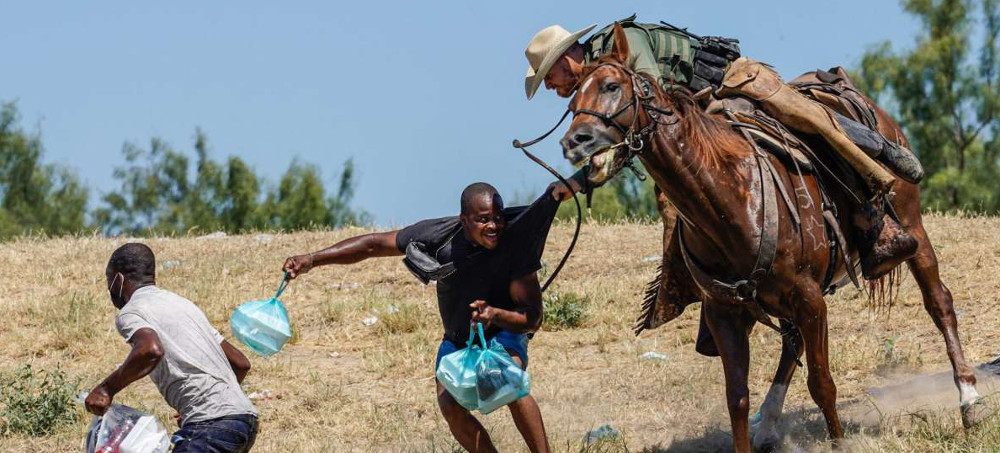 A United States Border Patrol agent on horseback attempts to stop a Haitian migrant from entering Texas on Sept. 19. (photo: Paul Ratje/Getty)
A United States Border Patrol agent on horseback attempts to stop a Haitian migrant from entering Texas on Sept. 19. (photo: Paul Ratje/Getty)
A group of 11 Haitian asylum seekers is suing the Biden administration, accusing the U.S. government of physical abuse, racial discrimination and other rights violations when they were forced to shelter under a bridge in Del Rio, Texas. The class-action lawsuit comes after images of Border Patrol agents whipping Haitian asylum seekers from horseback went viral in September, drawing outrage from rights groups. The plaintiffs in the case are also demanding the U.S. government allow the return of the thousands of Haitian asylum seekers deported from the Del Rio encampment. Guerline Jozef, co-founder and executive director of the Haitian Bridge Alliance, which filed the class-action lawsuit, says the Biden administration’s policies harm vulnerable people. “We believe that the lawsuit will force the administration to be accountable for what we continue to see as anti-Black racism within the immigration system,” she says. “Immigration is a Black issue. We cannot disconnect that from the reality after what we saw under the bridge in Del Rio.”
A group of 11 Haitian asylum seekers has filed a class-action lawsuit against the Biden administration, accusing the government of physical and verbal abuse, racial discrimination, denial of due process, and other severe rights violations while they were forced to take shelter under a bridge in the borderlands of Del Rio, Texas, in September. It was in Del Rio where U.S. Border Patrol agents on horseback whipped Haitian asylum seekers as they waded across the Rio Grande. One of the plaintiffs says she was, quote, “terrorized by officers on horseback.” As part of the lawsuit, the plaintiffs are also demanding the U.S. government allow the return of the thousands of Haitian asylum seekers deported from the Del Rio encampment.
We’re joined right now by Guerline Jozef, co-founder and executive director of the Haitian Bridge Alliance, which is part of the class-action suit. Guerline recently won the Robert F. Kennedy Human Rights Award. Congratulations, Guerline, and welcome back to Democracy Now! Can you talk about the —
GUERLINE JOZEF: Thank you so much, Amy. Thank you so much for having me.
AMY GOODMAN: Can you talk about the significance of this lawsuit?
GUERLINE JOZEF: Absolutely, Amy. We believe that the lawsuit will force the administration to be accountable for what we continue to see as anti-Black racism within the immigration system. We clearly understand from the testimonies and reports of the people who were abused, the witnesses and potential victims of what happened, including Mirard Joseph, who is the gentleman we all saw in that picture being grabbed by the officer on horseback, pushing and really abusing him.
So, the whole lawsuit is really in solidarity of the people who came and asked for safety, the people that the administration have decided to disappear by expelling and deporting them, by silencing their voices and their stories. So this is why we felt it was necessary to hold the administration accountable.
JUAN GONZÁLEZ: And, Guerline, so far, the Biden administration has allowed over 120 deportation flights, with about 14,000 migrants of Haitian descent being deported. Are all of them being sent back to Haiti?
GUERLINE JOZEF: Absolutely, which is a painful reality for our community. As of September, the people we saw under the bridge, close to 11,000 of them have been deported and expelled, including the gentleman we saw on the picture. And under President Biden, as you mentioned, 120 flights have been sent to Haiti, even in the middle of the extreme uprising, as we have spoken about before, as we see the country continues to go under extreme political unrest. At the same time, the United States is putting a Level 4 — do not travel to Haiti — and asking U.S. citizens who are in Haiti to leave the country immediately, and then deporting asylum seekers, people who have come here simply in search of protection, sending them back to Haiti.
JUAN GONZÁLEZ: And the administration has also begun a new Remain in Mexico program for asylum seekers. How is the Mexican government dealing with those who are told to remain in Mexico, if they are from Africa or Haiti or non-Spanish-speaking countries?
GUERLINE JOZEF: What the government has done, they have expanded MPP, Remain in Mexico, which we really call the migrant persecution protocol. As of right now, they have expanded it to include everyone from the Western Hemisphere, including people from Haiti, Jamaica, Brazil.
And what does that do? For Haitians specifically, they are in limbo, because Title 42 is still in full effect. That means they can expel and deport them under Title 42, and then return them to Mexico under MPP, or just leave them to be unable to get protection, understanding that Black people in Mexico cannot hide. They are extremely vulnerable, extremely visible. That’s why we stand against Title 42, against MPP, and demand that the administration provide a safe and orderly way for people to get protection and ask for asylum.
So we are really pushing really hard and standing with our plaintiffs, with our brothers and sisters in social protection. And we will hold President Biden and the entire administration accountable for what we all witnessed, the horrific pictures, the horrific videos that we saw. They must be held accountable.
AMY GOODMAN: So, you have 11,000 Haitians deported back to Haiti. But in other immigration news, the Biden administration has announced plans to allow 20,000 more immigrant workers into the U.S. temporarily via the H-2B visa program, because companies are saying that they don’t have enough workers. Sixty-five hundred of the visas will be set aside for applicants from Guatemala, Honduras, El Salvador and Haiti. Can you talk about what’s going on here, deporting thousands and thousands, and then, what, will some of the people who have been deported be brought back up?
GUERLINE JOZEF: Absolutely not, not under that program. That’s why we are asking for the administration to bring the people back, because at the same time, as you just mentioned, Amy, it doesn’t make sense. And we also understand that it is extremely impossible for people to even get access to the U.S. Embassy in Haiti. So, even if that program was in effect, how will the people have access to the program? And why will they deport Haitians coming into the country and then say they will provide visas for people in search of protection?
So, we are calling on all of those to be held accountable. We are making sure that people have access to whatever protection that are afforded to them under the law. And we will continue to push to make sure that asylum seekers at the U.S.-Mexico border are protected no matter where they are from, but also understanding that the anti-Black racism is at the root of what we are watching. And we want to make sure people understand that immigration is a Black issue. We cannot disconnect that from the reality, after what we saw under the bridge in Del Rio.
AMY GOODMAN: Guerline Jozef, we want to thank you for being with us, co-founder and executive director of the Haitian Bridge Alliance.
By the way, tune in to our holiday special on Friday when we speak to NSA whistleblower Edward Snowden and Pulitzer Prize-winning journalists Glenn Greenwald and Chris Hedges. Next week, we’ll bring you a 25th anniversary special, as well as an hour with Noam Chomsky, as part of our year-end conversations.
That does it for today’s show. Democracy Now! is produced with Renée Feltz, Mike Burke, Deena Guzder, Messiah Rhodes, Nermeen Shaikh, María Taracena, Tami Woronoff, Charina Nadura, Sam Alcoff, Tey-Marie Astudillo, John Hamilton, Robby Karran, Hany Massoud and Mary Conlon. Our general manager is Julie Crosby. Special thanks to Becca Staley, Paul Powell, Mike Di Filippo, Miguel Nogueira, Hugh Gran, Denis Moynihan, David Prude and Dennis McCormick.
 Dozens of Palestinian protestors were injured on Thursday in clashes with Israeli soldiers in a village northwest of the West Bank city of Nablus, Palestinian medics and eyewitnesses said. (photo: AFP)
Dozens of Palestinian protestors were injured on Thursday in clashes with Israeli soldiers in a village northwest of the West Bank city of Nablus, Palestinian medics and eyewitnesses said. (photo: AFP)
Dozens of Palestinian protestors were injured on Thursday in clashes with Israeli soldiers in a village northwest of the West Bank city of Nablus, Palestinian medics and eyewitnesses said.
Eyewitnesses in the village told Xinhua that clashes between the demonstrators and the Israeli soldiers broke out earlier on Thursday. They added that the protestors organized a demonstration against Israeli settlers' assaults and expansion of settlements.
The clashes broke out in the village shortly after hundreds of Israeli settlers, under the protection of Israeli soldiers, attempted to break into the village, the Palestinian official news agency WAFA reported.
In the past few days, the tensions between Israel and the Palestinians have been flaring in the West Bank over the Israeli measures. Two Palestinians were killed on Tuesday and Wednesday.
Meanwhile, Saleh al-Arouri, deputy chief of the Islamic Resistance Movement (Hamas) told the pro-movement Al-Aqsa TV channel that there is a clear ascending trend of tension in the West Bank as a result of the Israeli occupation practices.
Diplomatic ties between Israel and the Palestinians were interrupted in 2014 due to the Palestinian rejection of the Israeli policies of expanding settlements and the Israeli measures against the Palestinians in East Jerusalem.
The Palestinians want to establish an independent Palestinian state alongside Israel on all the Palestinian territories occupied by Israel in 1967, including the entire West Bank and the Gaza Strip, with East Jerusalem as its capital.
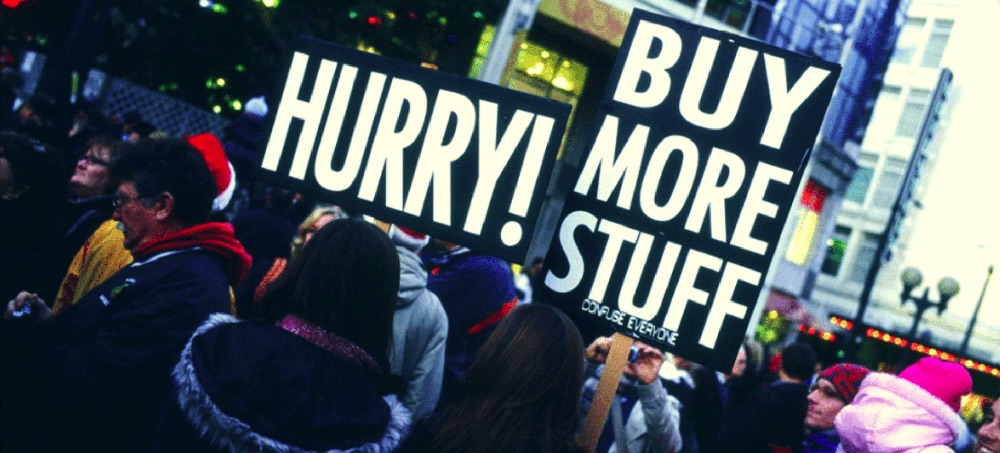 'American consumerism is a year-round thing, but things really go into overdrive in the weeks between Thanksgiving and Christmas.' (photo: AP)
'American consumerism is a year-round thing, but things really go into overdrive in the weeks between Thanksgiving and Christmas.' (photo: AP)
We start with the foundation, and work our way up.
The consulting firm Deloitte reports that 73 percent of retail executives expect higher spending this holiday season as compared to last, bringing the per-shopper average right back up to its 2019 fighting weight of almost $1,500. But as we know, many of those purchases will sooner or later (often sooner) end up in some dusty closet, donation pile, or trash bin. When you consider the amount of resources — water, land, carbon emissions — and underpaid, exploited human labor that go into goods that are often simply landfill-bound, it is hard not to be horrified.
And for what? In many cases, holiday buying habits are driven by a need to meet imagined expectations, an attempt to bring happiness to loved ones. While giving and receiving gifts can impart delight and even temporary joy, overbuying for the sake of obligation can also cause emotional and financial distress.
American consumerism is a year-round thing, but things really go into overdrive in the weeks between Thanksgiving and Christmas. When you get into the question of whether these habits are more grounded in religion or tradition, you risk getting stuck in a real quagmire. But for the sake of argument, let’s say that winter gift-giving, be it for Christmas or Hanukkah or Diwali, is a form of religious expression. But that doesn’t mean that we have a spiritual mandate to make a pilgrimage to Target. And you don’t have to take my word for it — in the Western world you don’t get much more influential in religious authority than the Pope, and the Supreme Pontiff has some firm thoughts on the matter.
In the Laudato Si, Pope Francis’ 2015 essay on our moral obligations with regard to climate change, he wrote: “The pace of consumption, waste, and environmental change has so stretched the planet’s capacity that our contemporary lifestyle, unsustainable as it is, can only precipitate catastrophes, such as those which even now periodically occur in different areas of the world.” (Let’s put aside the irony of this coming from the Catholic Church, an institution rather historically notorious for corruption and hoarding of wealth. When the Pope is right, he’s right.)
And yet, taking the “consume” out of Christmas is far easier said than done. We’re up against some powerful forces, including many billions of dollars in corporate advertising and a strong American cultural compulsion to shower our loved ones with gifts.
So how do we actually do it? Well, we start with the foundation, and work our way up.
The idea of consumerism as a form of contemporary religion — “America’s religion,” if you will — is not particularly new. The theory goes that we assert identity through which possessions we buy, define ourselves by affinity to various brands, and make our life’s purpose about having a lucrative enough career to buy what we want. The mall is our church, the credit card our rosary, et cetera.
In the cultural anthropologist Ernest Becker’s 200-page essay, “Escape from Evil,” his final work published posthumously, he explains that the inclination to accumulate possessions comes from an innate desire for security. In ancient societies, the ability to give plenty of gifts both as expressions of generosity and goodwill to community members and as offerings to the gods established the gift-giver in a position of power and respect.
“The origin of human drivenness,” he wrote, “is religious because man experiences creatureliness; the amassing of a surplus, then, goes to the very heart of human motivation, the urge to stand out as a hero, to transcend the limitations of the human condition and achieve victory over impotence and finitude.”
So there, you have a sort of psycho-evolutionary motive, wherein “I shop, therefore I am” takes on a whole new significance.
But if shopping is supposed to be a strategy to triumph over the threat of sad, solitary existence, it’s not a very effective one. Study after survey after story confirms that buying great heaping mounds of stuff does not actually improve our existence in the long term. Economists are developing new ways of measuring what makes a society satisfied with life, because wealth and the ability to purchase possessions (beyond the trappings of a certain level of needs-meeting comfort) are no longer considered particularly meaningful metrics of it.
Materialistic values have been tied to depression, anxiety, and insecurity. We’re even willing to spend money on methods to get us to stop buying so much stuff! Japanese decluttering scion Marie Kondo, for example, built an entire wildly profitable enterprise off of the ways in which the great oppressive weight of our belongings make us actively unhappy — an enterprise, it should be noted, that now includes a store where you can buy more stuff.
When you live in a consumerist society, it is not particularly easy to avoid consumption when you are simply trying to enjoy yourself. Even the most basic features of many interpersonal relationships are to some extent dependent on it. If you want to ask someone on a date, you’ll probably go to a restaurant or a bar or a movie theater; if you’re a teenager who wants a place to go to with your friends, you’ll go hang out at some sort of commercial center; if you want to show someone you care for them, you buy them presents at Christmas. If you don’t do any of these, you will be operating outside the norm, and risking rejection of your peers.
A litany of philosophers and sociologists and psychologists have argued that this hamster-wheel model of self-satisfaction is an (albeit poor) substitute for personal fulfillment and happiness. The Swedish sociologist Magnus Böstrom writes, “consumer culture is often said to be built on the experience of satisfaction as transitory. It fosters a sense that demands are insatiable.” And the psychologist John Schumaker warned at length about the “insanity” that that culture propagates, coming to the conclusion that it “results in an emotional void that is experienced as failure because of the persistence of emptiness that mocks all attempts at satisfaction.”
In other words, giving up consumerism means taking up the hard question of, what truly makes us happy? Before we can find that answer, we have to do a fair bit of deprogramming. Which takes us to another specter of Yuletide torment: Capitalism.
In the bone-biting chill of Scottish November, Reverend Billy, the leading “preacher” of the Church of Stop Shopping, brought his congregational choir to have their voices heard at the COP26 climate conference in Glasgow. The group is not actually a religious one. Rather, they are an anti-consumerist performance troupe whose singing and dancing routines urge their audience to consider changing their heavily polluting ways. By, for example, stopping shopping — or at least doing it way less.
But circling the Scottish Event Campus, the venue for COP26, the choir members found they just couldn’t get an audience with the actual delegates. The conference itself was housed in “these big buildings that all have different shapes — it’s just kind of a postmodern hell, that architecture,” Reverend Billy — government name William Talen — told me over the phone after the fact. There were highways and waterways and other forms of confounding infrastructural blockades that all conspired to form a sort of labyrinth around the conference center, and the group, at several points, found themselves stymied.
“Postmodern hell” is a familiar setting for the Church of Stop Shopping. Reverend Billy has spent the past two decades leading the group in protesting environmental sins in a wide variety of venues: Times Square, multiple outposts of Starbucks and Walmart, the Mall of America, and, more recently, the JP Morgan Chase Bank headquarters in New York.
The structures that protect and nurture the urge to shop are mighty fortresses indeed. Zygmunt Bauman, a famous Polish sociologist, wrote that one reason we’re so trapped in a consumerist cycle is because leisure — the ostensible goal of wealth — has become both commodified and profitable, making it “the turn of the consumers, rather than producers, to be exploited.” In other words, your boredom or malaise is someone else’s opportunity for profit.
The entire purpose of a capitalist system is to build and accumulate assets (aka capital), and the American experiment has definitely succeeded in that regard. Today, we have many very profitable corporations and wealthy individuals with a vested interest in maintaining our cultural obsession with buying and owning more and more stuff.
But to be able to participate in said stuff-owning, you have to have money. If you don’t have enough money to buy all the things you want, you are actively encouraged by companies and financial institutions to take out lines of credit and go into interest-accumulating debt. The psychological, physical, and economic impacts of significant debt — particularly on low-income families — are well-documented, and they are profoundly negative: heart attacks, chronic pain, homelessness, to name a few.
While there’s no doubt that the choices of individuals help perpetuate an unsustainable cycle of consumption, it would be as profoundly off-mark to criticize those with limited means for our consumerist nightmare as it is to criticize them for the climate crisis. The impact of what the bottom 10 percent consumes so massively pales in comparison to that of the top 10 percent, as an analysis by the Financial Times recently found. (That differential is greater in the United States than in any other country.) But our lifestyle options are not limited to “impoverished and struggling” and “in possession of a personal jet.” There are ample examples of middle-class and even wealthy families who have enough money to be comfortable but still feel trapped in an ever-more-stressful cycle of debt and spending.
“What I argue is that the United States is like a backpacker, but a backpacker who has this enormous pack, overloaded, falling backward, angry, straps are cutting into us, like an overturned turtle that can’t right itself, and we’re mad as hell,” says the documentarian John de Graaf, who has researched consumerist culture for decades. “And we are blaming everything — immigrants, women, taxes, government, minorities — for this misery that we feel, instead of looking at the crazy priorities that get us there.”
But what would an alternative to those crazy (work-obsessed, wealth-obsessed, environmentally apathetic at best) priorities look like? Perhaps a level of social infrastructure that allows people to actually enjoy their lives. Say, a four-day work week, government-ordained paid time off, or subsidized child care. Quality over quantity, so to speak.
To that end, there is a contingent of escapist Americans who like to point to Scandinavian countries and say: See, they’ve got it figured out. They have year-long paid parental leave, they can nestle their babies in a government-provided box of free onesies. Surely their priorities are in the right place.
“That’s bullshit,” says the sociologist Magnus Böstrom. Despite the fact that many Nordic countries have comparatively extensive welfare benefits, “the income gap is drastically widening in Sweden, and there’s all sorts of mass consumerist behavior. There is no real policy and politics and culture in Sweden to downsize.”
But Böstrom has been researching — in Sweden — why and how people do decide to downsize, and what happens when they do. The “why” is usually driven by a dissatisfaction with life combined with distress about the ecological impacts of consumption, the “how” usually entails working less to have more free time, and the “what happens” is, surprise, a greater satisfaction with life.
“I think too few people ask these questions: What do I do with my life? What is well-being, actually? Is it just to continue as usual and follow the norms — is this a meaningful life?” he says. “So that has similarities, of course, with religious thoughts — that they reflect on their existence.”
Philosophy is well and good, but let’s bring this holiday conversation back to the ghost of consumerism present — and by that I mean the presents themselves. This time of year is associated with peak capitulation to our American-capitalist grooming, but it’s also an opportunity to reconnect with our values and reinvent traditions for a new generation.
April Dickinson, who documents her dogged attempts at a minimal-buying, zero-waste lifestyle on Instagram, explained that her bicultural upbringing helped inform her current approach to holiday giving. On her Chinese mother’s side, there were no objects bestowed on many celebratory occasions, just money and delicious food. On her white American father’s side, big piles of gifts at Christmas were the norm. As she and her brother grew older, they realized that, in either case, the memories of how they spent the time with family were far more vivid than their recollections of what they had actually received. Later, Dickinson saw the same long-term indifference toward physical presents play out with her own young children.
“Kids really love and are excited about a toy for like two minutes, and then they’re kind of over it,” she said. “Seeing that happen in real time, in front of my eyes, I was like: ‘We need to adjust why we’re doing this.’”
Dickinson found that pushing back against the great weight of materialism worked best as a process of slow reduction for her family: gradually smaller and tighter wishlists, and open communication with relatives about what really matters to her. But for others making the attempt, she emphasized the importance of not being too harsh on yourself. “We only have so much capacity to always be upholding something, and swimming upstream is very, very exhausting. So, give yourself some grace, and just commit to what you’re able to commit to.”
Part of that commitment problem is that a non-consumerist Christmas — to say nothing of a non-consumerist America! — is still so hard to imagine. Even writing this essay, I myself struggled to imagine what a life with less stuff would look like on a society-wide level. I found myself coming back to the words of Michi Saagiig Nishnaabeg writer Leanne Betasamosake Simpson, who wrote in her novel Noopiming: The Cure for White Ladies, that the white architects of this country and its institutions “have really structured the fucked-up-ed-ness in a seemingly impenetrable way.” That certainly resonates when you try to do something as ostensibly simple as eschew or even reduce gifts at the holidays.
But if there’s a silver lining to our buying habit’s sticking power, it’s that it actually speaks to our primal desire and potential for change. In an analysis of the very idea of the religious trappings of materialism, Finnish theologian Mikko Kuhrenlati wrote that the “absolute act of dreaming can be interpreted as the engine of consumerism,” a kind of beautiful bit of optimism. We are shopping to achieve some imagined better life or version of ourselves that will be achievable with this car or that lipstick.
What comes next, I suppose, is pushing that imagining of a good life beyond coveting what we can see in a store window or Instagram ad. Is this season not known for miracles?
Follow us on facebook and twitter!
PO Box 2043 / Citrus Heights, CA 95611

